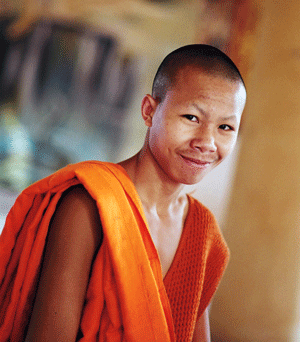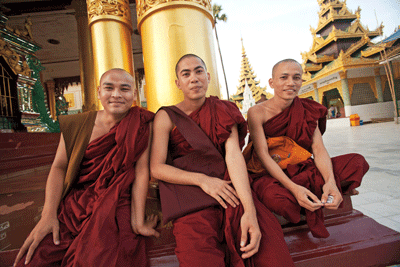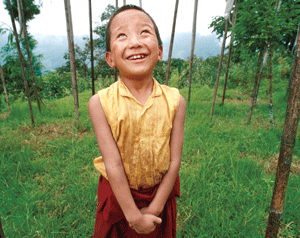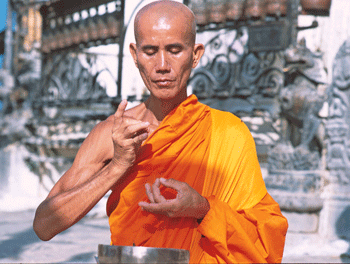The introduction to The Art of Living by Thich Nhat Hanh says “Spirituality is not religion. It is a path for us to generate happiness, understanding, and love, so we can live deeply each moment of our life. Having a spiritual dimension in our lives does not mean escaping life or dwelling in a place of bliss outside this world but discovering ways to handle life’s difficulties and generate peace, joy, and happiness right where we are, on this beautiful planet.”
Photographer Geoff Oliver Bugbee, drawn to the peaceful, happy faces and purposeful actions of Buddhist monks from various orders around the world, captured the accompanying images during his travels starting in 1994 to share their lessons of living in the present with others. Below, Sister Hien Nghiem (Sister True Dedication), of Thich Nhat Hanh’s Plum Village order in the South of France, shares her spiritual journey and insights.

For me, Buddhism is more a way of living, an art of living, than a religion. It is ancient wisdom—more than 2,500 years of it. Thich Nhat Hanh is one of those great lights who will go down in history as someone who has made these teachings effortlessly relevant and helpful to our modern way of living. He often teaches and writes so simply, with such elegance, it’s hard to see all the wisdom and brilliance within and behind the words. It’s a bit like watching Michael Jackson dance. Part of his genius was making his dancing look so effortless—and he was one of the best dancers of his generation. For me, Thich Nhat Hanh’s books are like that. They look simple, but they’re genius.
An Oasis of Calm
The ancient depth of Buddhism has the capacity to address our deepest concerns. In the book The Art of Living, Thich Nhat Hanh shares eloquently and with great depth a very accessible Buddhist way to approach questions like, “What does it mean to be alive?” or “What should I do with my one, precious life?” or “Where do we go when we die?” or simply, “Who am I?”

As an engaged Buddhist community, our monasteries are a kind of oasis, a refuge for people to come and live a mindful way of life alongside us, all year round. I’m currently living in Plum Village, France, and we recently had more than 8,000 people come to stay with us for a week or more in 2016. We help people learn how to cultivate a moment of happiness and how to handle a moment of suffering, of challenge, when things are just too much. We help people learn how to relax, how to arrive in every step, how to land into the present moment and find peace and ease there. We don’t learn these things in school, so oftentimes people are learning it for the first time with us.
Teaching in Every Moment
Thich Nhat Hanh used to say that we are very lucky: We can already see the impact of our mindfulness practices and teachings on people, just in how their faces relax and brighten up after a week with us. So our life is strangely public. Everywhere we go, our life is our message. We do our best to cultivate joy and happiness. Sometimes people see us cry, but most of the time they see us smile.

We’re human: humans practicing a deep life of mindfulness. That touches people. Some of us may live our lives so that day flows into another day, and we live just to “get through it.” We do things other people suggest we do. We do what everyone expects us to do. But if we’re really honest with ourselves, I think all of us need and want a spiritual dimension to our lives. Spirituality helps reclaim our lives, to live the kind of life we want to live. We dare to dream, and we dare to realize our ideals.
Living in mindfulness is like living in high-resolution. Suddenly we’re awake to the hyper-connectivity of everything. And we realize that we are not alone and that everything we do, no matter how small, has meaning. It’s part of the song of life.
About Geoff Oliver Bugbee
“For me, photographing Buddhist monks began as a peripheral undertaking on my photo assignments in Asia. The practice of compassion and nonviolence are personal pillars of strength in my life, so I’ve always been intrigued with the spiritual deeper dive and lifestyle of Buddhist monks and nuns. No matter my whereabouts, without exception monks have allowed me into their daily business—whether it be walking in their footsteps in the Yangon, Myanmar, streets for alms; observing a head-shave ritual in Sikkim, India; or poking into the middle of a cacophonous monastic debate in Lhasa, Tibet.”
(Visited 541 times, 1 visits today)










